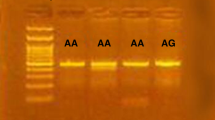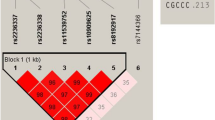Abstract
Alopecia areata is an autoimmune disease in which activation of autoreactive T cells and inflammatory immune signals target the hair follicles autoantigens. Although cytokines are involved in regulating autoimmune inflammation, the specific involvement of these molecules in the pathogenesis of alopecia areata has been remained unsettled. Here, a possible influence of IL12B, IL17A, and IL23R variations on susceptibility to alopecia areata in Iranian patients was investigated. Genotyping of IL12B (rs3212227), IL17A (rs2275913), and IL23R (rs10889677) variants were performed by extracting genomic DNA from patients and controls. Gene expression was analyzed by real-time RT-PCR. The frequency of IL12B and IL23R gene polymorphisms is significantly higher in the patients than controls, while no significant difference was found for IL17A. Stratification of the patients with respect to age at disease onset indicated that CC genotype of IL12B (rs3212227) and AA genotype of IL23R (rs10889677) gene polymorphisms are significantly associated with late-onset alopecia areata disease. In contrast to IL17A and IL23R, IL12B gene expression levels elevated in patients to that of controls, but genotypes had no effect on levels of gene expression. Overall, our data confirmed that the IL12B and IL23R polymorphisms are associated with the risk to develop alopecia areata in our population.
This is a preview of subscription content, access via your institution
Access options
Subscribe to this journal
Receive 6 digital issues and online access to articles
$119.00 per year
only $19.83 per issue
Buy this article
- Purchase on Springer Link
- Instant access to full article PDF
Prices may be subject to local taxes which are calculated during checkout


Similar content being viewed by others
References
Guo H, Cheng Y, Shapiro J, McElwee K. The role of lymphocytes in the development and treatment of alopecia areata. Expert Rev Clin Immunol. 2015;11:1335–51.
Alkhalifah A, Alsantali A, Wang E, McElwee KJ, Shapiro J. Alopecia areata update: part I. Clinical picture, histopathology, and pathogenesis. J Am Acad Dermatol. 2010;62:177–88. quiz 89–90.
Villasante Fricke AC, Miteva M. Epidemiology and burden of alopecia areata: a systematic review. Clin Cosmet Investig Dermatol. 2015;8:397–403.
Biran R, Zlotogorski A, Ramot Y. The genetics of alopecia areata: new approaches, new findings, new treatments. J Dermatol Sci. 2015;78:11–20.
Teng MW, Bowman EP, McElwee JJ, Smyth MJ, Casanova JL, Cooper AM, et al. IL-12 and IL-23 cytokines: from discovery to targeted therapies for immune-mediated inflammatory diseases. Nat Med. 2015;21:719–29.
Qian C, Jiang T, Zhang W, Ren C, Wang Q, Qin Q, et al. Increased IL-23 and IL-17 expression by peripheral blood cells of patients with primary biliary cirrhosis. Cytokine. 2013;64:172–80.
Fransen K, van Sommeren S, Westra HJ, Veenstra M, Lamberts LE, Modderman R, et al. Correlation of genetic risk and messenger RNA expression in a Th17/IL23 pathway analysis in inflammatory bowel disease. Inflamm Bowel Dis. 2014;20:777–82.
Carroll JM, McElwee KJ, L EK, Byrne MC, Sundberg JP. Gene array profiling and immunomodulation studies define a cell-mediated immune response underlying the pathogenesis of alopecia areata in a mouse model and humans. J Investig Dermatol. 2002;119:392–402.
Subramanya RD, Coda AB, Sinha AA. Transcriptional profiling in alopecia areata defines immune and cell cycle control related genes within disease-specific signatures. Genomics. 2010;96:146–53.
Malik K, Guttman-Yassky E. Cytokine targeted therapeutics for alopecia areata: lessons from atopic dermatitis and other inflammatory skin diseases. J Investig Dermatol Symp Proc. 2018;19:S62–s4.
Suarez-Farinas M, Ungar B, Noda S, Shroff A, Mansouri Y, Fuentes-Duculan J, et al. Alopecia areata profiling shows TH1, TH2, and IL-23 cytokine activation without parallel TH17/TH22 skewing. J Allergy Clin Immunol. 2015;136:1277–87.
Bain KA, McDonald E, Moffat F, Tutino M, Castelino M, Barton A, et al. Alopecia areata is characterized by dysregulation in systemic type 17 and type 2 cytokines, which may contribute to disease-associated psychological morbidity. Br J Dermatol. 2020;182:130–7.
Cargill M, Schrodi SJ, Chang M, Garcia VE, Brandon R, Callis KP, et al. A large-scale genetic association study confirms IL12B and leads to the identification of IL23R as psoriasis-risk genes. Am J Hum Genet. 2007;80:273–90.
Safrany E, Szell M, Csongei V, Jaromi L, Sipeky C, Szabo T, et al. Polymorphisms of the IL23R gene are associated with psoriasis but not with immunoglobulin A nephropathy in a Hungarian population. Inflammation. 2011;34:603–8.
Zwiers A, Seegers D, Heijmans R, Koch A, Hampe J, Nikolaus S, et al. Definition of polymorphisms and haplotypes in the interleukin-12B gene: association with IL-12 production but not with Crohn’s disease. Genes Immun. 2004;5:675–7.
Xu WD, Xie QB, Zhao Y, Liu Y. Association of Interleukin-23 receptor gene polymorphisms with susceptibility to Crohn’s disease: a meta-analysis. Sci Rep. 2015;5:18584.
Orozco G, Gonzalez-Gay MA, Paco L, Lopez-Nevot MA, Guzman M, Pascual-Salcedo D, et al. Interleukin 12 (IL12B) and interleukin 12 receptor (IL12RB1) gene polymorphisms in rheumatoid arthritis. Hum Immunol. 2005;66:710–5.
Farago B, Magyari L, Safrany E, Csongei V, Jaromi L, Horvatovich K, et al. Functional variants of interleukin-23 receptor gene confer risk for rheumatoid arthritis but not for systemic sclerosis. Ann Rheum Dis. 2008;67:248–50.
Sandip C, Tan L, Huang J, Li Q, Ni L, Cianflone K, et al. Common variants in IL-17A/IL-17RA axis contribute to predisposition to and progression of congestive heart failure. Medicine. 2016;95:e4105.
Stappers MH, Thys Y, Oosting M, Plantinga TS, Ioana M, Reimnitz P, et al. Polymorphisms in cytokine genes IL6, TNF, IL10, IL17A and IFNG influence susceptibility to complicated skin and skin structure infections. Eur J Clin Microbiol Infect Dis. 2014;33:2267–74.
Bogunia-Kubik K, Swierkot J, Malak A, Wysoczanska B, Nowak B, Bialowas K, et al. IL-17A, IL-17F and IL-23R gene polymorphisms in Polish patients with rheumatoid arthritis. Arch Immunol Ther Exp. 2015;63:215–21.
Hayashi R, Tahara T, Shiroeda H, Saito T, Nakamura M, Tsutsumi M, et al. Influence of IL17A polymorphisms (rs2275913 and rs3748067) on the susceptibility to ulcerative colitis. Clin Exp Med. 2013;13:239–44.
Yaghini N, Mahmoodi M, Hassanshahi G, Asadikaram G, Arababadi MK, Rezaeian M, et al. Genetic variation of IL-12B (+1188 region) is associated with its decreased circulating levels and susceptibility to Type 2 diabetes. Biomark Med. 2012;6:89–95.
Duerr RH, Taylor KD, Brant SR, Rioux JD, Silverberg MS, Daly MJ, et al. A genome-wide association study identifies IL23R as an inflammatory bowel disease gene. Science. 2006;314:1461–3.
Lew BL, Cho HR, Haw S, Kim HJ, Chung JH, Sim WY. Association between IL17A/IL17RA gene polymorphisms and susceptibility to alopecia areata in the Korean Population. Ann Dermatol. 2012;24:61–5.
Aytekin N, Akcali C, Pehlivan S, Kirtak N, Inaloz S. Investigation of interleukin-12, interleukin-17 and interleukin-23 receptor gene polymorphisms in alopecia areata. J Int Med Res. 2015;43:526–34.
Akatsu T, Nakamura M, Satoh M, Hiramori K. Increased mRNA expression of tumour necrosis factor-alpha and its converting enzyme in circulating leucocytes of patients with acute myocardial infarction. Clin Sci. 2003;105:39–44.
Ghaderian SM, Akbarzadeh Najar R, Tabatabaei Panah AS. Tumor necrosis factor-alpha: investigation of gene polymorphism and regulation of TACE-TNF-alpha system in patients with acute myocardial infarction. Mol Biol Rep. 2011;38:4971–7.
Urabe S, Isomoto H, Ishida T, Maeda K, Inamine T, Kondo S, et al. Genetic polymorphisms of IL-17F and TRAF3IP2 could be predictive factors of the long-term effect of infliximab against Crohn’s Disease. Biomed Res Int. 2015;2015:416838.
Conic RZ, Miller R, Piliang M, Bergfeld W, Atanaskova Mesinkovska N. Comorbidities in patients with alopecia areata. J Am Acad Dermatol. 2017;76:755–7.
Blaumeiser B, van der Goot I, Fimmers R, Hanneken S, Ritzmann S, Seymons K, et al. Familial aggregation of alopecia areata. J Am Acad Dermatol. 2006;54:627–32.
Moravvej H, Tabatabaei-Panah PS, Abgoon R, Khaksar L, Sokhandan M, Tarshaei S, et al. Genetic variant association of PTPN22, CTLA4, IL2RA, as well as HLA frequencies in susceptibility to alopecia areata. Immunol Investig. 2018;47:666–79.
Moravvej H, Tabatabaei-Panah PS, Ebrahimi E, Esmaeili N, Ghaderian SMH, Ludwig RJ, et al. TNF-alpha -308G/A gene polymorphism in bullous pemphigoid and alopecia areata. Hum Antibodies 2018;26:201–7.
Tabatabaei-Panah PS, Moravvej H, Arian S, Fereidonpour I, Behravesh N, Atoon A, et al. Overlapping and distinct FAS/FASLG gene polymorphisms in alopecia areata in an Iranian population. Immunol Investig. 2020;49:2014–14.
Rajabi F, Amoli MM, Robati RM, Almasi-Nasrabadi M, Jabalameli N, Moravvej H. The association between genetic variation in Wnt transcription factor TCF7L2 (TCF4) and alopecia areata. Immunol Investig. 2019;48:555–62.
Gilhar A, Shalaginov R, Assy B, Serafimovich S, Kalish RS. Alopecia areata is a T-lymphocyte mediated autoimmune disease: lesional human T-lymphocytes transfer alopecia areata to human skin grafts on SCID mice. J Investig Dermatol Symp Proc. 1999;4:207–10.
Wasserman D, Guzman-Sanchez DA, Scott K, McMichael A. Alopecia areata. Int J Dermatol. 2007;46:121–31.
Tabarkiewicz J, Pogoda K, Karczmarczyk A, Pozarowski P, Giannopoulos K. The role of IL-17 and Th17 lymphocytes in autoimmune diseases. Arch Immunol Ther Exp. 2015;63:435–49.
Oppmann B, Lesley R, Blom B, Timans JC, Xu Y, Hunte B, et al. Novel p19 protein engages IL-12p40 to form a cytokine, IL-23, with biological activities similar as well as distinct from IL-12. Immunity. 2000;13:715–25.
Zhou L, Yao F, Luan H, Wang Y, Dong X, Zhou W, et al. Functional polymorphisms in the interleukin-12 gene contribute to cancer risk: evidence from a meta-analysis of 18 case-control studies. Gene. 2012;510:71–7.
Peng LL, Wang Y, Zhu FL, Xu WD, Ji XL, Ni J. IL-23R mutation is associated with ulcerative colitis: a systemic review and meta-analysis. Oncotarget. 2017;8:4849–63.
Seegers D, Zwiers A, Strober W, Pena AS, Bouma G. A TaqI polymorphism in the 3’UTR of the IL-12 p40 gene correlates with increased IL-12 secretion. Genes Immun. 2002;3:419–23.
Yilmaz V, Yentur SP, Saruhan-Direskeneli G. IL-12 and IL-10 polymorphisms and their effects on cytokine production. Cytokine. 2005;30:188–94.
Morahan G, Huang D, Ymer SI, Cancilla MR, Stephen K, Dabadghao P, et al. Linkage disequilibrium of a type 1 diabetes susceptibility locus with a regulatory IL12B allele. Nat Genet. 2001;27:218–21.
Espinoza JL, Takami A, Nakata K, Onizuka M, Kawase T, Akiyama H, et al. A genetic variant in the IL-17 promoter is functionally associated with acute graft-versus-host disease after unrelated bone marrow transplantation. PLoS ONE. 2011;6:e26229.
Maalmi H, Beraies A, Charad R, Ammar J, Hamzaoui K, Hamzaoui A. IL-17A and IL-17F genes variants and susceptibility to childhood asthma in Tunisia. J Asthma. 2014;51:348–54.
Chen J, Deng Y, Zhao J, Luo Z, Peng W, Yang J, et al. The polymorphism of IL-17 G-152A was associated with childhood asthma and bacterial colonization of the hypopharynx in bronchiolitis. J Clin Immunol. 2010;30:539–45.
Acknowledgements
We would like to thank the Medical and Nursing staff of the Skin Research Center, Shohada Tajrish and Loghman Hakim hospitals at Tehran, Iran for helpful collaboration.
Author information
Authors and Affiliations
Corresponding author
Ethics declarations
Conflict of interest
The authors declare that they have no conflict of interest.
Ethics
The study protocol was considered and approved by the local ethics committee (Human Research Ethics Committee of Skin Research Center, Shahid Beheshti University of Medical Sciences). The investigation conforms to the principles outlined in the 1964 Declaration of Helsinki, revised in 2000.
Informed consent
Informed patient consent was obtained from all individuals.
Additional information
Publisher’s note Springer Nature remains neutral with regard to jurisdictional claims in published maps and institutional affiliations.
Rights and permissions
About this article
Cite this article
Tabatabaei-Panah, PS., Moravvej, H., Delpasand, S. et al. IL12B and IL23R polymorphisms are associated with alopecia areata. Genes Immun 21, 203–210 (2020). https://doi.org/10.1038/s41435-020-0100-1
Received:
Revised:
Accepted:
Published:
Issue Date:
DOI: https://doi.org/10.1038/s41435-020-0100-1
This article is cited by
-
Association of genetic polymorphisms in IL-23R and IL-17A with the susceptibility to IgA nephropathy in a Chinese Han population
Genes & Immunity (2022)
-
A functional microRNA binding site variant in IL-23R gene in systemic lupus erythematosus and rheumatoid arthritis: is there any correlation?
Molecular Biology Reports (2022)



